Hugh Cudlipp
(journalist, editor) | |
|---|---|
 | |
| Born | 28 August 1913 |
| Died | 17 May 1998 (Age 84) |
Journalist and newspaper editor noted for his work on the Daily Mirror in the 1950s and 1960s. | |
Hubert Kinsman Cudlipp, Baron Cudlipp was a Welsh journalist and newspaper editor noted for his work on the Daily Mirror in the 1950s and 1960s.
Life and career
Hugh Cudlipp was born in Cardiff, the youngest of three sons of William Christopher Cudlipp, a travelling salesman, and Bessie Amelia, née Kinsman.[1][2][3] He left the Howard Gardens High School for boys (later Howardian High School) at the age of fourteen, working for a number of short-lived local newspapers before transferring at the age of sixteen to Manchester and a job on the Manchester Evening Chronicle. In 1932, aged nineteen, he moved to London to take up a position as features editor of the Sunday Chronicle. In 1935, he joined the staff of the Daily Mirror.[4]
He was editor of the Sunday Pictorial (later renamed the Sunday Mirror) from 1937 to 1940. Whereas newspapers such as the Daily Mail and the Evening News had given support to the right-wing governments in Germany, Italy and Spain before the war, Cudlipp ensured that human right violations in these countries were reported. In July 1938 Hugh Cudlipp and Cecil King visited Winston Churchill at his home in Kent when together they planned the attack on Neville Chamberlain and his policy of appeasement.[5]
During the war he saw war service with the Royal Sussex Regiment, and was involved in the First Battle of El Alamein.[3] He was head of the army newspaper unit for the Mediterranean from 1943 to 1946, and oversaw the launch of a British forces' paper, Union Jack,[3] modelled on the US Stars and Stripes.
He thereafter returned to the Daily Mirror and the Sunday Pictorial until 1949; when owing to disagreements with his then boss, Harry Guy Bartholomew, he left to take the post of managing editor of the Sunday Express for a two-year stint. By 1951, Bartholomew had left, replaced by Cecil King, who reappointed Cudlipp, and with whom Cudlipp enjoyed a good working relationship for many years.[4]
In 1952, Cudlipp was made Editorial Director of the Sunday Pictorial and the Daily Mirror, in the period in which the latter sustained its position as one of the best-selling of British newspapers. Roy Greenslade identifies Cudlipp as the mastermind of the paper's editorial formula, responsible for design, choice of campaigns, gimmicks, stunts, and author of iconic headlines.[6]
Cudlipp was Chairman of the Mirror Group of newspapers from 1963 to 1967, where he oversaw the 1964 launch, as a broadsheet, of The Sun. Intended to replace the failing Daily Herald, the choice of format was to prevent it encroaching on Daily Mirror sales.[4] The paper was not successful and, in 1969, was sold to Rupert Murdoch, who turned it into a tabloid imitator of and competitor to the Daily Mirror; by 1978, it was outselling the Mirror.
From 1968 to his retirement in 1973, he was Chairman of the International Publishing Corporation. His brothers Percy Cudlipp and Reginald Cudlipp were also national newspaper editors.
Cudlipp was knighted in 1973 and created Baron Cudlipp, of Aldingbourne in the County of West Sussex in 1974. Initially a Labour peer, he joined the nascent Social Democratic Party in 1981.
In 1974, director/producer John Goldschmidt made the documentary film Telling It Like It Is: Cudlipp's Crusade, featuring Hugh Cudlipp about the "state of the nation", for ATV.[7] The IBA[8] insisted that the film was withdrawn from transmission so as not to conflict with legislation on broadcasting in periods just before general elections.[9] The script of the film was instead published in sections by several newspapers. The film was finally transmitted on ITV after the election.
Personal life
His first wife was Edith Parnell, who in 1929, when only a 16-year-old schoolgirl, had become the second person to swim across the Bristol Channel from Penarth to Weston-super-Mare.[10] She died in 1938.[11] His second wife, Eileen Ascroft, whom he married in 1945, died in 1962.[3][11] The following year he married Joan Latimer Hyland, known as Jodi, who died in August 2017.[12]
Legacy
After his death his widow, Jodi, joined with former colleagues from the British press to found the Cudlipp Trust with the aim of "education and furthering the interests and standing of journalism".[13] The trust organises the annual Hugh Cudlipp Lecture and student journalism prize.[12]
Event Participated in
| Event | Description |
|---|---|
| The Cecil King coup plot | 1968 coup plan for the United Kingdom |
References
- ↑ Oxford Dictionary of National Biography 2005-2008, ed. Lawrence Goldman, 2013, p. 274
- ↑ The New York Times Biographical Service, vol. 29, New York Times, Arno Press, 1998, p. 764
- ↑ a b c d Griffiths, Dennis, ed. (1992). The Encyclopedia of the British Press, 1422–1992. London & Basingstoke: Macmillan. pp. 178–79.
- ↑ a b c http://www.oxforddnb.com/view/article/69790
- ↑ https://spartacus-educational.com/Jcudlipp.htm
- ↑ Roy Greenslade, "Why all journalists should read Cudlipp's Publish and be Damned!", The Guardian, 8 December 2009
- ↑ Telling It Like It Is: Cudlipp's Crusade, BFI Film & TV Database
- ↑ "Be Damned If You Publish", New Law Journal, vol.124, No.5666, 19 September 1974, p. 853
- ↑ Transmission dates: Telling It Like It Is: Cudlipp's Crusade, BFI Film & TV Database
- ↑ https://web.archive.org/web/20130606055515/http://bookoxygen.com/?p=2007
- ↑ a b https://www.thetimes.co.uk/archive/article/1962-04-30/20/10.html
- ↑ a b https://www.theguardian.com/media/2017/aug/16/lady-cudlipp-obituary
- ↑ http://opencharities.org/charities/1108418
Wikipedia is not affiliated with Wikispooks. Original page source here